Page 125 of 514
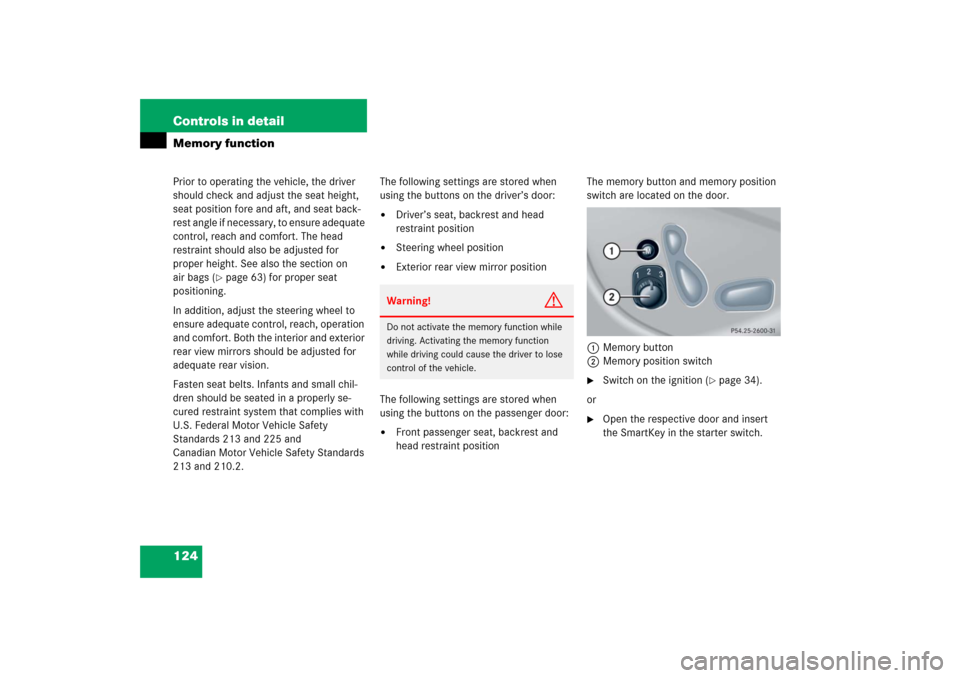
124 Controls in detailMemory functionPrior to operating the vehicle, the driver
should check and adjust the seat height,
seat position fore and aft, and seat back-
rest angle if necessary, to ensure adequate
control, reach and comfort. The head
restraint should also be adjusted for
proper height. See also the section on
air bags (
�page 63) for proper seat
positioning.
In addition, adjust the steering wheel to
ensure adequate control, reach, operation
and comfort. Both the interior and exterior
rear view mirrors should be adjusted for
adequate rear vision.
Fasten seat belts. Infants and small chil-
dren should be seated in a properly se-
cured restraint system that complies with
U.S. Federal Motor Vehicle Safety
Standards 213 and 225 and
Canadian Motor Vehicle Safety Standards
213 and 210.2.The following settings are stored when
using the buttons on the driver’s door:
�
Driver’s seat, backrest and head
restraint position
�
Steering wheel position
�
Exterior rear view mirror position
The following settings are stored when
using the buttons on the passenger door:
�
Front passenger seat, backrest and
head restraint positionThe memory button and memory position
switch are located on the door.
1Memory button
2Memory position switch
�
Switch on the ignition (
�page 34).
or
�
Open the respective door and insert
the SmartKey in the starter switch.
Warning!
G
Do not activate the memory function while
driving. Activating the memory function
while driving could cause the driver to lose
control of the vehicle.
Page 256 of 514
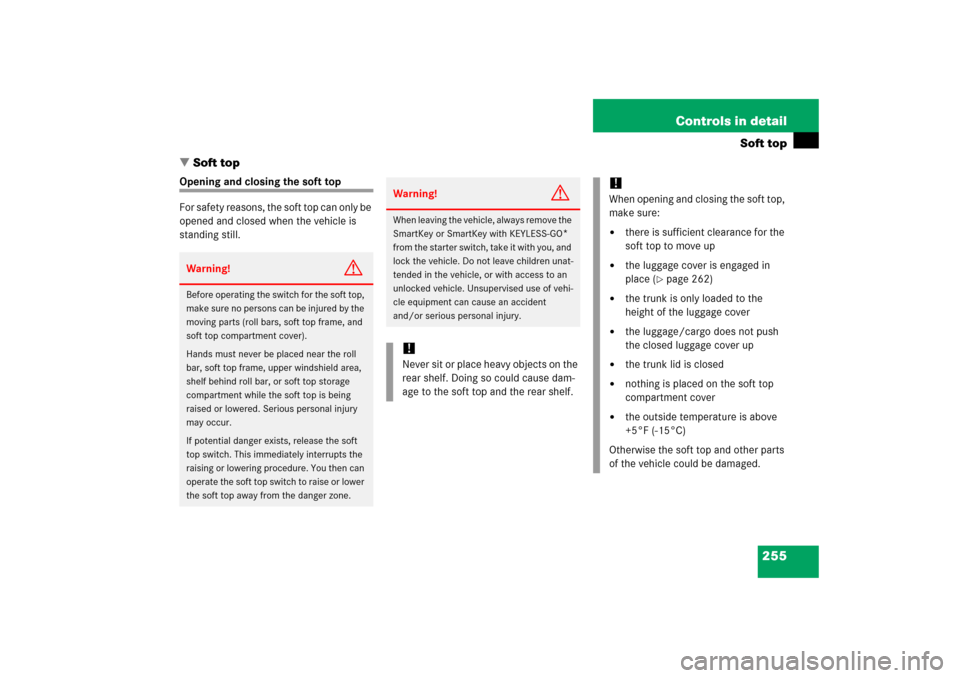
255 Controls in detail
Soft top
�Soft top
Opening and closing the soft top
For safety reasons, the soft top can only be
opened and closed when the vehicle is
standing still.Warning!
G
Before operating the switch for the soft top,
make sure no persons can be injured by the
moving parts (roll bars, soft top frame, and
soft top compartment cover).
Hands must never be placed near the roll
bar, soft top frame, upper windshield area,
shelf behind roll bar, or soft top storage
compartment while the soft top is being
raised or lowered. Serious personal injury
may occur.
If potential danger exists, release the soft
top switch. This immediately interrupts the
raising or lowering procedure. You then can
operate the soft top switch to raise or lower
the soft top away from the danger zone.
Warning!
G
When leaving the vehicle, always remove the
SmartKey or SmartKey with KEYLESS-GO
*
from the starter switch, take it with you, and
lock the vehicle. Do not leave children unat-
tended in the vehicle, or with access to an
unlocked vehicle. Unsupervised use of vehi-
cle equipment can cause an accident
and/or serious personal injury.
!Never sit or place heavy objects on the
rear shelf. Doing so could cause dam-
age to the soft top and the rear shelf.
!When opening and closing the soft top,
make sure:�
there is sufficient clearance for the
soft top to move up
�
the luggage cover is engaged in
place (
�page 262)
�
the trunk is only loaded to the
height of the luggage cover
�
the luggage/cargo does not push
the closed luggage cover up
�
the trunk lid is closed
�
nothing is placed on the soft top
compartment cover
�
the outside temperature is above
+5°F (-15°C)
Otherwise the soft top and other parts
of the vehicle could be damaged.
Page 263 of 514
262 Controls in detailSoft topLuggage cover
The luggage cover is located in the trunk.
1Luggage cover�
Open the trunk
Latch luggage cover
�
Pull luggage cover1 out in direction
of arrow until it engages in place.Folding back luggage cover
�
Press luggage cover1 in direction of
rear seat.!To prevent damage to the soft top or
luggage/cargo when lowering the roof:�
load trunk only to the height of the
luggage cover
�
do not permit luggage/cargo to
push up the closed luggage cover
�
do not place anything on the shelf
behind the roll bars
�
do not place anything on the soft
top compartment cover
!Never place anything behind the side
nets when the luggage cover has been
folded back. You could forget about ob-
jects placed there, which could result
in damage when operating the soft top.
Page 271 of 514
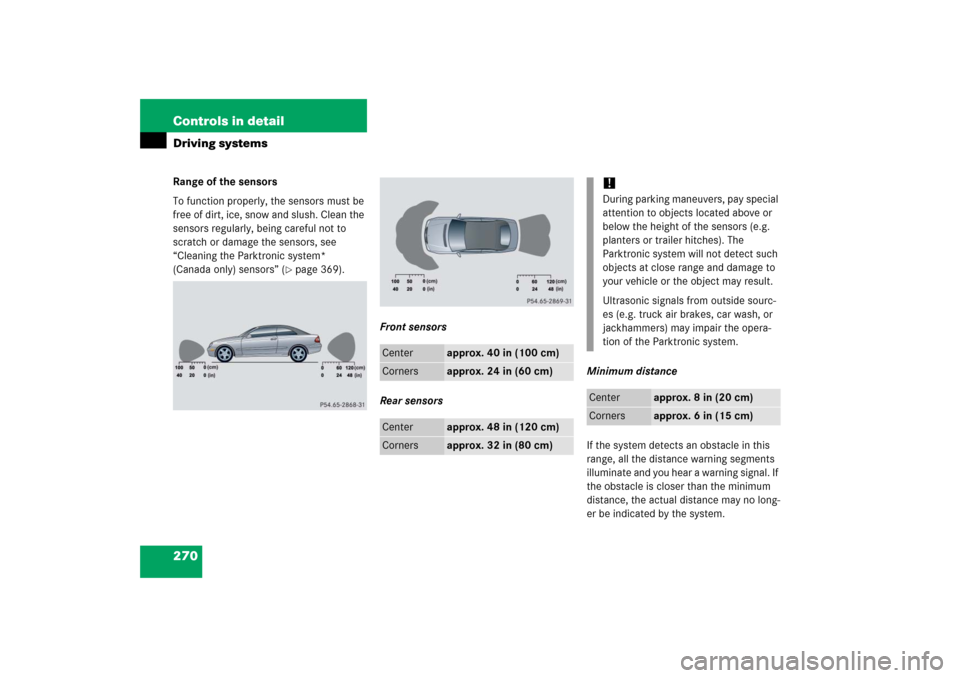
270 Controls in detailDriving systemsRange of the sensors
To function properly, the sensors must be
free of dirt, ice, snow and slush. Clean the
sensors regularly, being careful not to
scratch or damage the sensors, see
“Cleaning the Parktronic system*
(Canada only) sensors” (
�page 369).
Front sensors
Rear sensorsMinimum distance
If the system detects an obstacle in this
range, all the distance warning segments
illuminate and you hear a warning signal. If
the obstacle is closer than the minimum
distance, the actual distance may no long-
er be indicated by the system.
Center
approx. 40 in (100 cm)
Corners
approx. 24 in (60 cm)
Center
approx. 48 in (120 cm)
Corners
approx. 32 in (80 cm)
!During parking maneuvers, pay special
attention to objects located above or
below the height of the sensors (e.g.
planters or trailer hitches). The
Parktronic system will not detect such
objects at close range and damage to
your vehicle or the object may result.
Ultrasonic signals from outside sourc-
es (e.g. truck air brakes, car wash, or
jackhammers) may impair the opera-
tion of the Parktronic system.
Center
approx. 8 in (20 cm)
Corners
approx. 6 in (15 cm)
Page 278 of 514
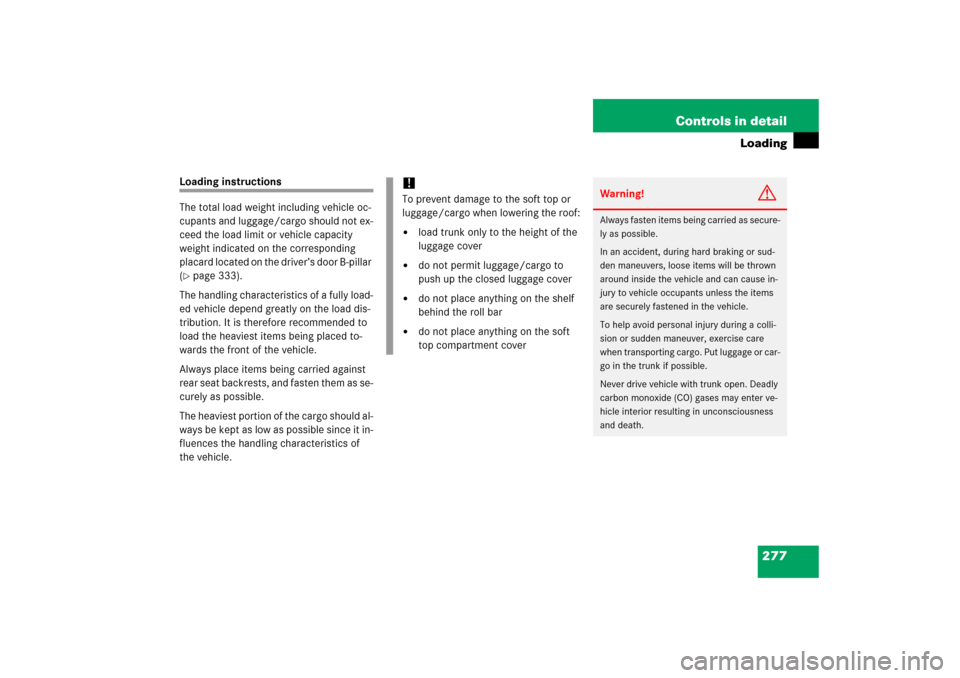
277 Controls in detail
Loading
Loading instructions
The total load weight including vehicle oc-
cupants and luggage/cargo should not ex-
ceed the load limit or vehicle capacity
weight indicated on the corresponding
placard located on the driver’s door B-pillar
(�page 333).
The handling characteristics of a fully load-
ed vehicle depend greatly on the load dis-
tribution. It is therefore recommended to
load the heaviest items being placed to-
wards the front of the vehicle.
Always place items being carried against
rear seat backrests, and fasten them as se-
curely as possible.
The heaviest portion of the cargo should al-
ways be kept as low as possible since it in-
fluences the handling characteristics of
the vehicle.
!To prevent damage to the soft top or
luggage/cargo when lowering the roof:�
load trunk only to the height of the
luggage cover
�
do not permit luggage/cargo to
push up the closed luggage cover
�
do not place anything on the shelf
behind the roll bar
�
do not place anything on the soft
top compartment cover
Warning!
G
Always fasten items being carried as secure-
ly as possible.
In an accident, during hard braking or sud-
den maneuvers, loose items will be thrown
around inside the vehicle and can cause in-
jury to vehicle occupants unless the items
are securely fastened in the vehicle.
To help avoid personal injury during a colli-
sion or sudden maneuver, exercise care
when transporting cargo. Put luggage or car-
go in the trunk if possible.
Never drive vehicle with trunk open. Deadly
carbon monoxide (CO) gases may enter ve-
hicle interior resulting in unconsciousness
and death.
Page 284 of 514
283 Controls in detail
Useful features
Opening telephone compartment�
Slide cover1 in direction of arrow and
open it fully.
Closing telephone compartment
�
Slide cover1 back.Armrest in the rear passenger
compartment�
Pull the top of the armrest out and fold
it down.
Cup holdersWarning!
G
In order to help prevent spilling liquids on
vehicle occupants and/or vehicle equip-
ment, only use containers that fit into the
cup holder. Use lids on open containers and
do not fill containers to a height where the
contents, especially hot liquids, could spill
during braking, vehicle maneuvers, or in an
accident. Liquids spilled on vehicle occu-
pants may cause serious personal injury.
Liquids spilled on vehicle equipment may
cause damage not covered by the
Mercedes-Benz Limited Warranty
When not in use, keep the cup holder
closed. An open cup holder may cause injury
to you and others when contacted during
braking, vehicle maneuvers, or in an
accident.
��
Page 322 of 514
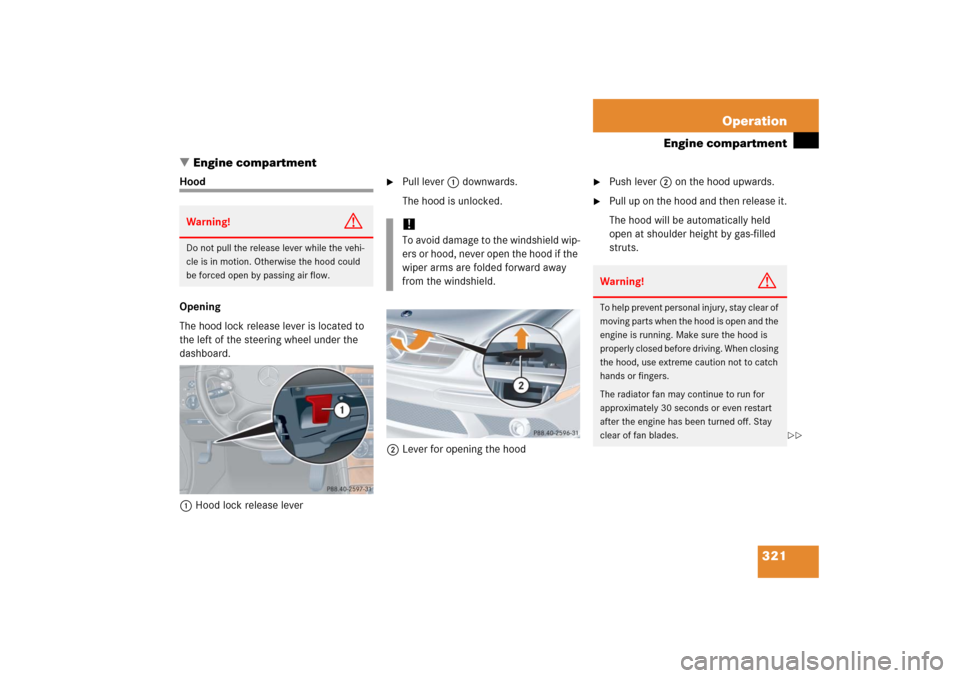
321 Operation
Engine compartment
�Engine compartment
Hood
Opening
The hood lock release lever is located to
the left of the steering wheel under the
dashboard.
1Hood lock release lever
�
Pull lever 1 downwards.
The hood is unlocked.
2Lever for opening the hood
�
Push lever 2 on the hood upwards.
�
Pull up on the hood and then release it.
The hood will be automatically held
open at shoulder height by gas-filled
struts.
Warning!
G
Do not pull the release lever while the vehi-
cle is in motion. Otherwise the hood could
be forced open by passing air flow.
!To avoid damage to the windshield wip-
ers or hood, never open the hood if the
wiper arms are folded forward away
from the windshield.
Warning!
G
To help prevent personal injury, stay clear of
moving parts when the hood is open and the
engine is running. Make sure the hood is
properly closed before driving. When closing
the hood, use extreme caution not to catch
hands or fingers.
The radiator fan may continue to run for
approximately 30 seconds or even restart
after the engine has been turned off. Stay
clear of fan blades.
��
Page 323 of 514
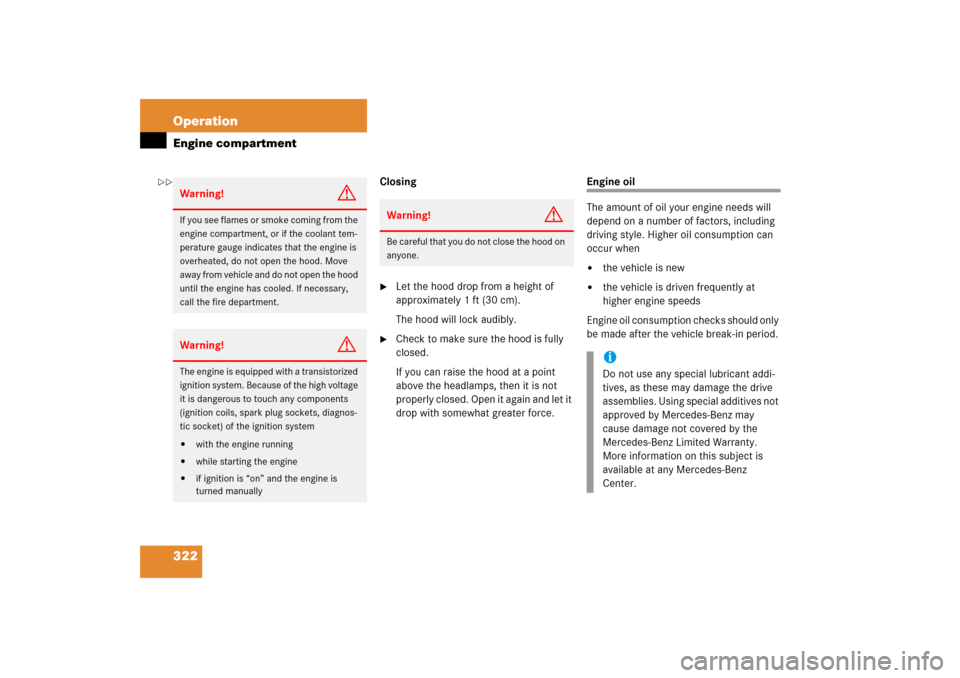
322 OperationEngine compartment
Closing�
Let the hood drop from a height of
approximately 1 ft (30 cm).
The hood will lock audibly.
�
Check to make sure the hood is fully
closed.
If you can raise the hood at a point
above the headlamps, then it is not
properly closed. Open it again and let it
drop with somewhat greater force.
Engine oil
The amount of oil your engine needs will
depend on a number of factors, including
driving style. Higher oil consumption can
occur when�
the vehicle is new
�
the vehicle is driven frequently at
higher engine speeds
Engine oil consumption checks should only
be made after the vehicle break-in period.
Warning!
G
If you see flames or smoke coming from the
engine compartment, or if the coolant tem-
perature gauge indicates that the engine is
overheated, do not open the hood. Move
away from vehicle and do not open the hood
until the engine has cooled. If necessary,
call the fire department.Warning!
G
The engine is equipped with a transistorized
ignition system. Because of the high voltage
it is dangerous to touch any components
(ignition coils, spark plug sockets, diagnos-
tic socket) of the ignition system�
with the engine running
�
while starting the engine
�
if ignition is “on” and the engine is
turned manually
Warning!
G
Be careful that you do not close the hood on
anyone.
iDo not use any special lubricant addi-
tives, as these may damage the drive
assemblies. Using special additives not
approved by Mercedes-Benz may
cause damage not covered by the
Mercedes-Benz Limited Warranty.
More information on this subject is
available at any Mercedes-Benz
Center.
��